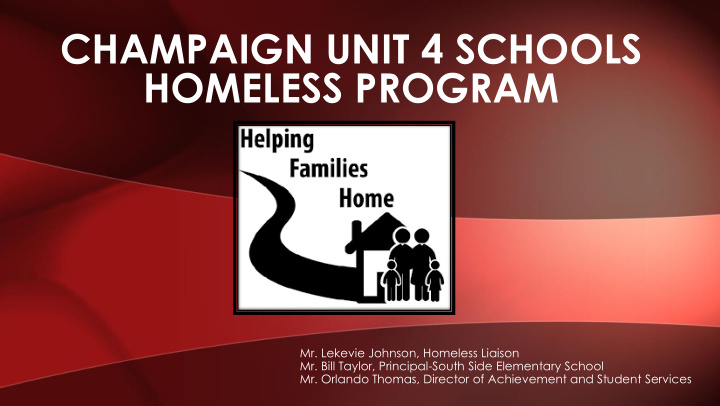



CHAMPAIGN UNIT 4 SCHOOLS HOMELESS PROGRAM Mr. Lekevie Johnson, Homeless Liaison Mr. Bill Taylor, Principal-South Side Elementary School Mr. Orlando Thomas, Director of Achievement and Student Services
THE MCKINNEY-VENTO ACT • Subtitle VII-B of the McKinney-Vento Homeless Assistance Act (42 U.S.C. § 11431 et seq.) • Reauthorized in 2001 by Title X, Part C of the No Child Left Behind Act • Establishes the definition of homeless used by schools • Ensures that children and youth experiencing homelessness have immediate and equal access to public education • Provides for educational access, stability, and support to promote school success • Needed to address the unique barriers faced by many homeless students
OVERVIEW • McKinney-Vento eligibility is determined on a case-by- case basis by examining the living arrangement of each student. • Some instances will be clear-cut; others will require further inquiry and then a judgment call. • If the living arrangement does not meet all three criteria (fixed, regular, and adequate) , it is considered a homeless situation. • The examples of homeless situations listed in the definition address some of the more common situations of homelessness; the list of examples is not exhaustive.
THE DEFINITION • Individuals who lack a fixed, regular, and adequate nighttime residence , including: – Sharing the housing of other persons due to loss of housing, economic hardship, or a similar reason – Living in motels, hotels, trailer parks, or camping grounds due to the lack of alternative adequate accommodations – Living in emergency or transitional shelters – Awaiting foster care placement
FIXED, REGULAR, AND ADEQUATE • Fixed: – Stationary, permanent, not subject to change • Regular: – Used on a predictable, routine, consistent basis – Consider the relative permanence • Adequate: – Lawfully and reasonably sufficient – Sufficient for meeting the physical and psychological needs typically met in a home environment Can the student go to the SAME PLACE (fixed) EVERY NIGHT (regular) to sleep in a SAFE AND SUFFICIENT SPACE (adequate)?
THE DEFINITION – Have a primary nighttime residence that is a public or private place not designed for or ordinarily used as a regular sleeping accommodation for human beings – Living in cars, parks, public spaces, abandoned buildings, substandard housing, bus or train stations, or similar settings – Migratory children living in the circumstances described above – Unaccompanied youth living in the circumstances described above
PROCESS STEP 1: GET THE FACTS • Use an enrollment questionnaire for all students; this will assist with identifying eligible students. • If the form indicates a possible homeless situation, refer to the local liaison to determine eligibility. • Discuss the living arrangement with the family/student in a private place and with sensitivity. • Ask additional questions respectfully, as needed. (these are often very personal discussions for the family)
PROCESS STEP 2: ASK QUESTIONS • Inform the family about your reason for asking questions - to determine potential eligibility • Avoid using the word “homeless”: some families may want to avoid the stigma; others may not consider themselves homeless and yet they might be eligible. • (FERPA) Avoid contacting persons outside the school system to probe for more information regarding the family’s living arrangement; see NCHE’s Confirming Eligibility brief at www.serve.org/nche/downloads/briefs/verif_ll.pdf
PROCESS STEP 3: ANALYZE THE FACTS • Does the student’s living arrangement fit into one of the examples of homelessness in the law? • If not, would the student qualify for services because he/she lives in another type of living arrangement that does not meet the fixed, regular, and adequate standard? • Use the information/questions contained in the Determining Eligibility brief to assist in answering these questions.
PROCESS STEP 4: UTILIZE RESOURCES Bev Baker Regina Parnell Regional Office of Education #9 Champaign - Ford Counties 200 S. Fredrick St, Rantoul, IL 61866 Phone: 217-893-3219 / Fax: 217-893- 0024 OR 217-819-5965 Your Partner in Education
CHAMPAIGN UNIT 4 DATA Homeless Families 45 40 40 35 35 30 25 20 20 15 10 3 5 0 Early Childhood Elementary Middle High Early Childhood Elementary Middle High
SCHOOL SELECTION • Students experiencing homelessness may attend either: – The local attendance area school: • Any public school that students living in the same attendance area are eligible to attend – The school of origin: • The school the child or youth attended when permanently housed; or • The school in which the child or youth was last enrolled
TRANSPORTATION • School districts must provide the following transportation for McKinney-Vento students: – Transportation to and from the school of origin – Comparable transportation • Based on the best interest of the student and in consultation with the parent, the district ultimately determines the mode of transportation.
UNACCOMPANIED HOMELESS YOUTH • An unaccompanied youth’s living arrangement must meet the Act’s definition of homeless for him/her to qualify for McKinney - Vento services • The McKinney-Vento Act defines unaccompanied youth as a child or youth “not in the physical custody of a parent or guardian” • There is no lower age limit for unaccompanied youth; the upper age limit (as with all McKinney-Vento eligible students) is your state’s upper age limit for public education (usually 21, sometimes older for IDEA) • A youth can be eligible regardless of whether he/she was asked to leave the home or chose to leave; remember that sometimes there is “more than meets the eye” for youth’s home life situations
GOALS & INITIATIVES Goals Initiatives 1. Secure transportation for 80% of students 2. Secure emergency shelter for 80% of families 3. Monitor referrals to community agencies to reduce the recidivism rate 4. Connect to community agencies/resources
HOMELESS ACTION GROUP • Two meetings so far this school year • Comprised of several Unit 4 employees • Community members on the team include – Darlene Kloeppel – Regina Parnell - ROE – Beverley Baker and Sue Grey – United Way
HOMELESS ACTION GROUP GOALS • Resource guides for families • Resource reference lists for schools • Update Unit 4 website • Develop relationships with local agencies
Questions?
Recommend
More recommend